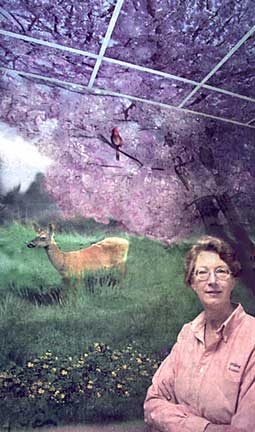| Home | |
| Mural Ideas | |
| About the Murals | |
| About Us | |
| Faux Windows | |
| Pricing and Services | |
| What Others say | |
| Contact Information |
OFF THE WALLCommercial work gives artist a chance to branch outWisconsin
State Journal, Monday, April 21, 2003 MOUNT HOREB—Peggy Flora Zalucha has heard all the puns she cares to about her commercial art business—things like, "business is looking up; high overhead, low prices; and the sky's the limit."
LEFT:
Business is looking up for Peggy Flora Zalucha, the Mount Horeb
artist who has been turning walls and ceilings into pieces of
art since 1998. She is seen here with her most recent work in
the X-ray room at UW Hospital.
Zalucha's
business is producing custom ceiling graphics for such places
as hospital exam rooms, dental offices, and office waiting rooms—artwork
on the ceiling meant to dress up or cover up probIem areas or
provide a relaxing mood to a room. Zalucha has produced the Concerts on the Square poster for the past 20 years and will continue to do so, she assures. Her art also can be found in many public buildings around Dane County and Southern Wisconsin and even on some Madison buses. Her new, commercial ceiling art venture, Millennium Murals and Milling Around, is operated through her Mount Horeb studio, Zalucha Studio, at 119 S. Second St. “We sort of got started in 1998 when Pleasant rowland, of Pleasant Co., came to me about art for behind her doll displays in their new Chicago store," Zalucha said. After reviewing the project, Zalucha said she realized she couldn't do it by herself and sought the help of two artist friends, Tamlyn Akins and Douglas Haynes. "We had fun working together. That was the start of it all," Zalucha said. She also uses some student artists. From the walls behind dolls in Chicago, Zalucha and her artists have risen to the challenge, so to speak, and have since produced artwork on ceilings and walls around the country. Their biggest customer, however, is the UW Hospital in Madison, where their artwork adorns the ceilings of several rooms including patient rooms, exam rooms and over the nurses' station in the Burn Center. And, if you visit the cafeteria at the hospital you will see their art staring back at you where there were once windows before the hospital built an addition. The painted scenes, which change with the seasons, were Zalucha's first project at the hospital. This past week she put the finishing touches on a project in one of the hospital's X-ray rooms where patients will be able to view an outdoor scene with deer, rabbits, a squirrel and even a frog as they lie on the X-ray table. The artwork starts on one wall of the room and spreads to the ceiling tiles where clouds and birds soar overhead. Zalucha admits that most of the company's work is sky scenes and not all that challenging artistically, but it is a challenge in some cases to be able to solve a problem for a client. It has moved Zalucha and her colleagues into new forms of art, mainly computer generated. "Most of our projects are created and done on the computer and not the palette," she said. Zalucha said with new printers installed earlier this year, her artists can produce work 60 inches wide by 110 feet long on canvas, vinyl or paper. Most of it is on vinyl, she noted, because it is more durable, washable and can be made fire retardant, which is often needed in public buildings. Because the areas to be covered are often room-size, the work is reproduced in sections. "In some cases it's like putting together a jigsaw puzzle," Zalucha said, pointing out that most of the ceiling creations are on 24-inch-by-24-inch ceiling tile panels. That means taking the large overall picture and cutting it to fit the tiles and, still create a continuous piece of art. Her husband, Tony Zalucha, a longtime archeological consultant, will be retiring and joining the business, Peggy Zalucha said. "He will be handling the office and helping out on the installations," she said. "He enjoys the installation work. I think it goes back to the days in the '60s and '70s when we were UW hippies putting up crazy wallpaper in our apartment," she quipped. |
| Other services offered at emill.com |
| Website Design |
| Graphic Design |
| Custom Ceiling Tiles |
| Large Format Printing |
| Zalucha Studio Fine Art |
| Large Murals |
| Millennium Murals & Milling Around / all part of Zalucha
Studio LLC All images on this site Copyright Zalucha 2003 |
